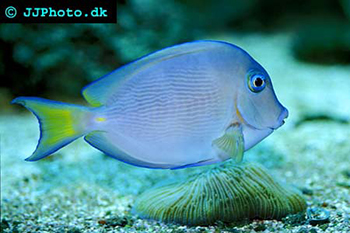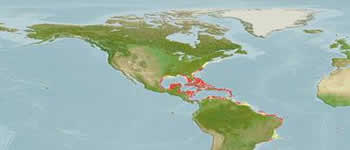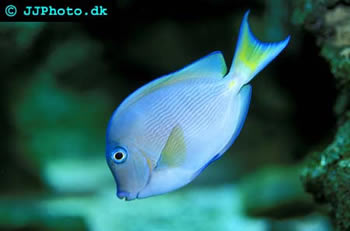The Blue Tang Surgeonfish
Acanthurus coeruleus

Taxonomy
Kingdom: Animalia
Phylum: Chordata
Subphylum: Vertebrata
Superclass: Gnathostomata
Class: Actinopterygii
Order: Perciformes
Family: Acanthuridae
Genus: Acanthurus
Species: coeruleus
Description
The Blue Tang is one of 75 species in the Surgeonfish family. This family, Acanthuridae, of fishes is called surgeonfish because of their very sharp, mobile spines on either side of their tail that favors surgeons’ scalpels. Acanthurus coeruleus, also known as the Blue Tang Surgeonfish reaches up to 39 cm in length when fully mature. In adults coloration is usually deep blue and occasionally purple. Mature fish will occasionally change colors between pale white and near-black. Color changes can vary between sexes and can evolve all or parts of the fish. The Blue Tang Surgeonfish is a laterally compressed, “pancake-shaped” fish with high eyes, yellow caudal spine at the base of the tail, sub-terminal mouth, and a dorsal fin that ends at the caudal peduncle. This fish has the most distinctive coloration of all of the Western Atlantic Surgeonfish. The younger juvenile fish are bright yellow and older juveniles have a blue or a orange-brown color to their body with grey stripes. It is called the Surgeonfish because of its sharp caudal spine that is found in a horizontal grove on the peduncle and is often extended when the fish is in a aggressive state. Acanthurus coeruleus has 9 spines, 26-28 dorsal soft rays, 3 anal spines, and 24-26 anal soft rays. A single fish has a life span up to 12 to 15 years.

Location
Blue Tang Surgeonfish can be found in shallow marine reefs throughout the western Atlantic Ocean, the Caribbean Sea, and the Gulf of Mexico. Although these fish are most common in the Caribbean, coastal Florida, and the Bahamas.
Habitat
Blue Tang Surgeonfish live on hard-coral reefs. They can also be found near soft corals, algal beds, and rubble. When the fish is younger, it prefers areas with plenty of cover. They often shelter in coral holes and crevices. Blue Tang Surgeonfish can be found at depths of 2 to 40 meters deep.

Behavior
Blue Tang Surgeonfish are solitary fish and have home ranges that vary in size. They are not migratory fish. Once adults, Blue Tang Surgeonfish have three distinct social modes: territorial, wandering, and schooling. They are active during the day while feeding, but often dart off in crevices among the reef at night to avoid predators.
Reproduction
Mating takes place over sandy patches between reefs in large resident aggregations. It is shown that they prefer locations from 6 to 10 m deep with strong currents to aid in sweeping the fertilized eggs off to sea. When the fish change from a uniform deep blue to a pale blue toward the front half of their body and a dark blue toward the rear indicates that the fish is ready for mating. Blue Tang Surgeonfish participate in a behavior called “spawning rush”. This is when the courting females and a small number of males leave the aggregation and release gametes at the water’s surface. Spawning usually occurs every day at a typical location between less than 20 individuals. The larger spawning happens in the afternoon three to eight days after the full moon in the winter months. Breeding usually only happens once or twice a year per fish. It takes one year for a single fish to reach sexual maturity. The eggs may take up to 24 hours to hatch.
Predators
Known predators of the Blue Tang Surgeonfish are Tuna, Bar Jack, Tiger Grouper, and other large carnivorous fishes.
Diet
Blue Tang Surgeonfish feed mostly on filamentous algae as they are herbivorous. They do not have a gizzard-like stomach so they avoid eating calcareous material (coral). They can be found feeding either singly, small grouped, or numbering over one hundred.
Ecology
Blue Tang Surgeonfish help to control the algae populations since this is their primary food. This helps prevent overgrowth and suffocation of local corals. They also eat algae off green turtles at cleaning stations.
Conservation Status
Acanthurus coeruleus is a secure species and is not on the IUCN Red list.
Personal Interest
I find personal interest in the Acanthurus coeruleus, or Blue Tang Surgeonfish, because of its defense and attack methods. While it’s primary defense is schooling to reduce chances of predator attack. Its attack mechanism is usually to solitary fish in the means of thrashing. It is also interesting how they can cause painful injuries to humans with their spine inflicting deep wounds open to infection. Also, if eaten Blue Tang Surgeonfish can be poisonous. They are also beautiful fish to see in aquariums!
Citation
Please note that the following references may have either been removed or relocated by the webpage owners since the time this student report was created.
Bester, C.. "Blue Tang." Biological profiles. Ichthyology, 2002. Web. 30 May 2012.< http://www.flmnh.ufl.edu/fish/gallery/descript/bluetang/bluetang.html>.
"Blue Tangs, Acanthurus." Marinebio. Marinebio, 1998. Web. 30 May 2012. <http://marinebio.org/species.asp?id=277>.
Froese, R.ed. "Acanthurus coeruleus." Fish Base. World Wide Web Electronic Publication, 15 Nov 2011. Web. 30 May 2012. <http://www.fishbase.org/summary/Acanthurus-coeruleus.html>.
Woodruff, G. 2006. "Acanthurus coeruleus" (On-line), Animal Diversity Web. Accessed May 30, 2012 at <http://animaldiversity.ummz.umich.edu/site/accounts/information/Acanthurus_coeruleus.html>
"Blue tang surgeonfish - Acanthurus coeruleus." Aquatic Community. N.p., 2004. Web. 30 May 2012.< http://www.aquaticcommunity.com/marinefish/bluetangsurgeonfish.php>.
Jensen, Johnny. "Acanthurus coeruleus." Aquarium Photo.dk. N.p., 30 May 2012. Web. 30 May 2012. <http://www.aquariumphoto.dk/acanthurus_coeruleus.htm>.